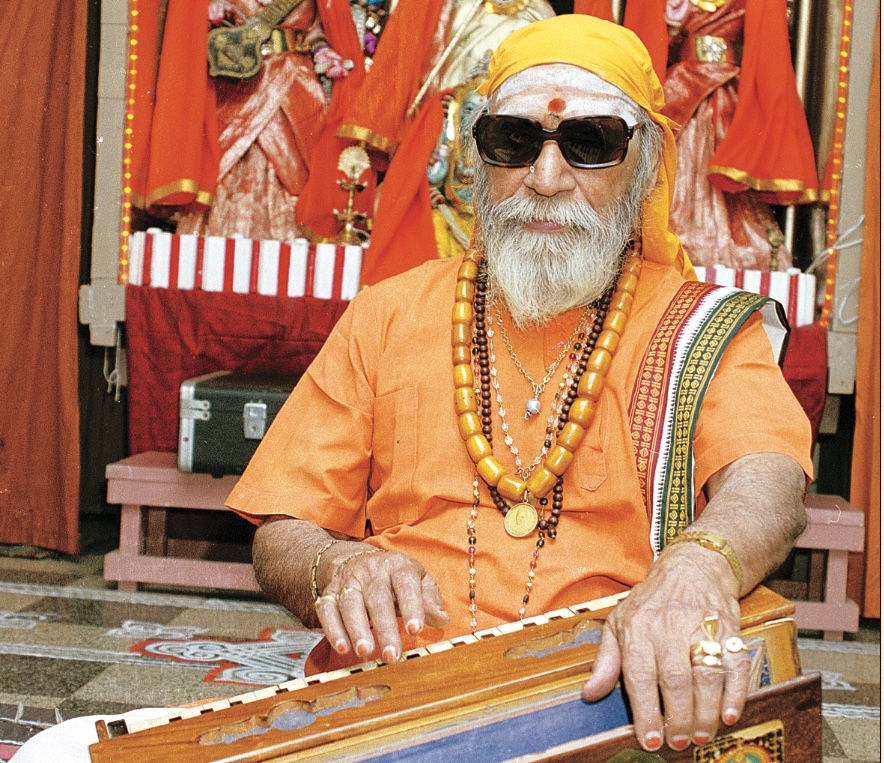With Kesav Mallia
Murugadas is already on stage getting ready as we arrive. The spotlight brightens his yellow bandanna and reflects a gleam off his black sunglasses. For an instant, his painted, red-nailed forefinger catches the light as it strikes middle C on his old, battered harmonium. Finding his pitch, he clears his throat and begins to chant “Om.” In the shadows behind him, an exquisitely dressed lady gracefully positions herself with a tambura (a stringed instrument) and begins strumming a drone. To her right, Saroja, Murugadas’ wife, busily lays out a collection of percussion instruments, fussing a bit to be sure she hasn’t forgotten anything. Rao, the seasoned drummer, unsheathes his mridangam (a south Indian drum) from its cloth case and tunes its upper head, socking its rawhide binding with a rock to change the pitch. The restless audience rustles to get as comfortable as 500 people can in the confined space. Slowly, everyone on stage and off becomes quietÑexcept for Murugadas. Sitting still as stone and calm as a lake, he looks like a king as he continues chanting “Om.” Finally, the concert takes wings.
That cool, breezy evening performance in late December of 1982 at the famed mountain-top temple in Palani Hills, South India, was recorded and is now famous. Yet it was not unlike thousands upon thousands of other concerts during the 60-year musical career of Pithukuli Murugadas. Today, the “singing sage” is still amazing crowds at Palani Hills and elsewhere around the globe as his popularity continues to grow.
Murugadas is usually thought of as a bhajana virtuoso, a great leader of group devotional singing. But, as any musician who has heard him will testify, he is much more. His natural voice is vibrantly trumpetic, and his singing skill is quintessential. Most importantly, he is a distinguished bhaktar (devotional person). His truly heart-felt piety shows through in his music and lends it a touch of magic that his audiences can resonate with. Although much has been said about Murugadas, the comment made most often is, “He is unforgettable.”
During a characteristic concert, which often lasts three hours or more, Murugadas slowly and carefully develops a long, leisurely musical pace toward crescendo. First, he establishes close rapport with his audience by leading simple bhajanas that everyone can easily follow. This may go on for an hour before he subtly begins to introduce more complex classical compositions that he sings solo or with his wife. All along the way, however, he keeps returning to audience participation. Occasionally, he will abruptly stop singing in the middle of a song, and as the music continues softly in the background, speak in dramatic monotone, telling stories and quoting scripture before majestically returning to the music. All of this builds in intensity until, toward the conclusion of the concert, he lets loose one of his many trademark songs. The audience thunders applause and the evening’s performance peaks like the culmination of a temple puja. As a denouement to all of this, he brings everything back down to earth with one final hand-clapping, foot-stomping bhajana. The crowd again roars. No one wants him to stop. Even India’s sharpest music critics have highly praised Murugadas’ great voice, musical versatility, undeniable spiritualityÑand, of course, his enchanting showmanship.
Born in Coimbatore as Balasubramanian, Murugadas expressed an uncanny love of God before he could even talk. At the age of seven he began singing devotional songs and was schooled in the basic fundamentals of music by his grandmother.
As he grew a little older, he was taken up by the revolutionary spirit of the day, leaving home at 15 to protest British rule as a “freedom fighter.” During the famous “freedom struggle of 1936” in Bangalore, he was seriously beaten by British police and completely lost the sight in his left eye. Yet, he held fast to his love of God and remained ever positive. Today, the sunglasses he wears to shield his partial blindness have become his trademark.
During a long pilgrimage when he was about 20 years of age, Murugadas had a spiritual experience that changed his life. Sitting on the banks of the Sarasvathi river in North India, he became engrossed in contemplation and heard an inner voice tell him in the Tamil language, “Go to South India. You have work to do there.” Cutting short his pilgrimage, he immediately left for Tamil Nadu to live the life of a singing saint.
By the age of 30, he had carved a notable niche as a professional musician. At that time, he lived in Palani Hills and had the opportunity to internalize his musical skills under the tutelage of Brahmananda Paradeshiyar, a siddhar, or great yogi with special powers. This teacher named him ÒPithukuli,Ó which means Òa spirited person.Ó Swami Ramadas, the head of Aanandashram in Kanjangad, North Kerala, added the title ÒMurugadas,Ó which means Òthe servant of Lord Muruga.Ó
By the age of 70, Murugadas was internationally famous and still going strong. Even today, at 83, he adamantly refuses to retire. He has written more than 3,000 songs and has released over 30 audio cassettesÑall devotional songs to Hindu Gods and Goddesses. Presently, he lives in Chennai, South India, with his wife, Saroja, whom he married when he was 58. He performs in seven languages and is Tamil NaduÕs most popular singing thespian. He is also much loved and famous in South Africa, Mauritius, Singapore, Malaysia and Sri Lanka, which he has visited 40 times in the last 40 years. He has developed a charity called Sri Jyothir Maya Devi Trust in Chennai.
When referring to himself, he never uses ÒI.Ó Instead he says Ivan (this person). Yet when begged to explain how a life such as his could leave a man humble, he leans forward and whispers, ÒHonestly speaking, inside me this ÒIÓ is very much there.Ó


